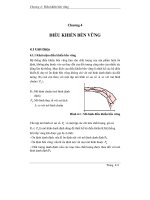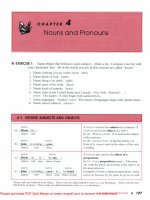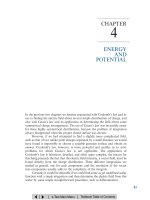Chapter4 a
Bạn đang xem bản rút gọn của tài liệu. Xem và tải ngay bản đầy đủ của tài liệu tại đây (1.4 MB, 45 trang )
Chapter 4: Network Layer
Chapter goals:
Overview:
understand principles behind
network layer services
routing principle: path selection
network layer services:
routing (path selection)
hierarchical routing
dealing with scale
IP
how a router works
Internet routing protocols reliable
advanced topics: IPv6, multicast
instantiation and implementation
in the Internet
transfer
intra-domain
inter-domain
what’s inside a router?
IPv6
multicast routing
4: Network Layer
4a-1
Network layer functions
transport packet from sending to
receiving hosts
network layer protocols in every host,
router
three important functions:
path determination: route taken by
packets from source to dest. Routing
algorithms
switching: move packets from router’s
input to appropriate router output
call setup: some network architectures
require router call setup along path
before data flows
application
transport
network
data link
physical
network
data link
physical
network
data link
physical
network
data link
physical
network
data link
physical
network
data link
physical
network
data link
physical
network
data link
physical
network
data link
physical
application
transport
network
data link
physical
4: Network Layer
4a-2
Network service model
Q: What service model for
“channel” transporting packets
from sender to receiver?
service abstraction
guaranteed bandwidth?
preservation of inter-packet timing (no
jitter)?
loss-free delivery?
in-order delivery?
congestion feedback to sender?
The most important
abstraction provided
by network layer:
? ?
?
virtual circuit
or
datagram?
4: Network Layer
4a-3
Virtual circuits
“source-to-dest path behaves much like telephone circuit”
performance-wise
network actions along source-to-dest path
call setup, teardown for each call before data can flow
each packet carries VC identifier (not destination host OD)
every router on source-dest path s maintain “state” for each passing connection
transport-layer connection only involved two end systems
link, router resources (bandwidth, buffers) may be allocated to VC
to get circuit-like perf.
4: Network Layer
4a-4
Virtual circuits: signaling protocols
used to setup, maintain teardown VC
used in ATM, frame-relay, X.25
not used in today’s Internet
application
transport
network
data link
physical
5. Data flow begins
4. Call connected
1. Initiate call
6. Receive data
3. Accept call
2. incoming call
application
transport
network
data link
physical
4: Network Layer
4a-5
Datagram networks: the Internet model
no call setup at network layer
routers: no state about end-to-end connections
no network-level concept of “connection”
packets typically routed using destination host ID
packets between same source-dest pair may take different paths
application
transport
network
data link
physical
1. Send data
2. Receive data
application
transport
network
data link
physical
4: Network Layer
4a-6
Network layer service models:
Network
Architecture
Internet
Service
Model
Guarantees ?
Congestion
Bandwidth Loss Order Timing feedback
best effort none
ATM
CBR
ATM
VBR
ATM
ABR
ATM
UBR
constant
rate
guaranteed
rate
guaranteed
minimum
none
no
no
no
yes
yes
yes
yes
yes
yes
no
yes
no
no (inferred
via loss)
no
congestion
no
congestion
yes
no
yes
no
no
Internet model being extented: Intserv, Diffserv
Chapter 6
4: Network Layer
4a-7
Datagram or VC network: why?
Internet
data exchange among computers
ATM
evolved from telephony
human conversation:
“elastic” service, no strict timing
req.
strict timing, reliability
“smart” end systems (computers)
requirements
can adapt, perform control, error
need for guaranteed service
recovery
“dumb” end systems
simple inside network, complexity
telephones
at “edge”
complexity inside network
many link types
different characteristics
uniform service difficult
4: Network Layer
4a-8
Routing
Routing protocol
5
Goal: determine “good” path
(sequence of routers) thru
network from source to dest.
Graph abstraction for routing
algorithms:
graph nodes are routers
graph edges are physical links
link cost: delay, $ cost, or
congestion level
2
A
B
3
2
1
D
C
3
1
5
F
1
E
2
“good” path:
typically means minimum cost
path
other def’s possible
4: Network Layer
4a-9
Routing Algorithm classification
Global or decentralized
information?
Global:
all routers have complete topology,
link cost info
“link state” algorithms
Decentralized:
router knows physically-connected
neighbors, link costs to neighbors
iterative process of computation,
exchange of info with neighbors
“distance vector” algorithms
Static or dynamic?
Static:
routes change slowly over time
Dynamic:
routes change more quickly
periodic update
in response to link cost changes
4: Network Layer 4a-10
A Link-State Routing Algorithm
Dijkstra’s algorithm
net topology, link costs known to all
nodes
accomplished via “link state
broadcast”
all nodes have same info
computes least cost paths from one
node (‘source”) to all other nodes
gives routing table for that node
iterative: after k iterations, know
least cost path to k dest.’s
Notation:
c(i,j): link cost from node i to j.
cost infinite if not direct neighbors
D(v): current value of cost of path
from source to dest. V
p(v): predecessor node along path
from source to v, that is next v
N: set of nodes whose least cost
path definitively known
4: Network Layer 4a-11
Dijsktra’s Algorithm
1 Initialization:
2 N = {A}
3 for all nodes v
4
if v adjacent to A
5
then D(v) = c(A,v)
6
else D(v) = infty
7
8 Loop
9 find w not in N such that D(w) is a minimum
10 add w to N
11 update D(v) for all v adjacent to w and not in N:
12
D(v) = min( D(v), D(w) + c(w,v) )
13 /* new cost to v is either old cost to v or known
14 shortest path cost to w plus cost from w to v */
15 until all nodes in N
4: Network Layer 4a-12
Dijkstra’s algorithm: example
Step
0
1
2
3
4
5
start N
A
AD
ADE
ADEB
ADEBC
ADEBCF
D(B),p(B) D(C),p(C) D(D),p(D) D(E),p(E) D(F),p(F)
2,A
1,A
5,A
infinity
infinity
2,A
4,D
2,D
infinity
2,A
3,E
4,E
3,E
4,E
4,E
5
2
A
B
2
1
D
3
C
3
1
5
F
1
E
2
4: Network Layer 4a-13
Dijkstra’s algorithm, discussion
Algorithm complexity: n nodes
each iteration: need to check all nodes, w, not in N
n*(n+1)/2 comparisons: O(n**2)
more efficient implementations possible: O(nlogn)
Oscillations possible:
e.g., link cost = amount of carried traffic
D
1
A
1
0
0
0
C
e
1+e
e
initially
B
2+e
D
0
1
A
1+e 1
C
0
0
B
… recompute
routing
0
D
1
A
0 0
C
2+e
B
1+e
… recompute
2+e
D
0
A
1+e 1
C
0
e
B
… recompute
4: Network Layer 4a-14
Distance Vector Routing Algorithm
iterative:
continues until no nodes
exchange info.
self-terminating: no “signal” to
stop
asynchronous:
nodes need not exchange
info/iterate in lock step!
distributed:
each node communicates only
with directly-attached
neighbors
Distance Table data structure
each node has its own
row for each possible destination
column for each directly-attached neighbor
to node
example: in node X, for dest. Y via neighbor
Z:
X
D (Y,Z)
distance from X to
= Y, via Z as next hop
Z
= c(X,Z) + minw{D (Y,w)}
4: Network Layer 4a-15
Distance Table: example
A
C
E
2
A
B
D
A
1
14
5
B
7
8
5
C
6
9
4
D
4
11
2
D
E
D
D (C,D) = c(E,D) + minw {D (C,w)}
= 2+2 = 4
E
D
c(E,D)
+
min
{D
(A,w)}
D (A,D) =
w
= 2+3 = 5 loop!
E
B
D (A,B) = c(E,B) + minw{D (A,w)}
= 8+6 = 14
cost to destination via
D ()
2
8
1
E
destination
7
B
1
loop!
4: Network Layer 4a-16
Distance table gives routing table
E
cost to destination via
Outgoing link
to use, cost
B
D
A
1
14
5
A
A,1
B
7
8
5
B
D,5
C
6
9
4
C
D,4
D
4
11
2
D
D,4
Distance table
destination
A
destination
D ()
Routing table
4: Network Layer 4a-17
Distance Vector Routing: overview
Iterative, asynchronous: each local
iteration caused by:
local link cost change
message from neighbor: its least cost
path change from neighbor
Distributed:
each node notifies neighbors only
when its least cost path to any
destination changes
neighbors then notify their
neighbors if necessary
Each node:
wait for (change in local link
cost of msg from neighbor)
recompute distance table
if least cost path to any dest
has changed, notify
neighbors
4: Network Layer 4a-18
Distance Vector Algorithm:
At all nodes, X:
1 Initialization:
2 for all adjacent nodes v:
3
D X(*,v) = infty
/* the * operator means "for all rows" */
X
4
D (v,v) = c(X,v)
5 for all destinations, y
X
6
send min D (y,w) to each neighbor /* w over all X's neighbors */
w
4: Network Layer 4a-19
Distance Vector Algorithm (cont.):
8 loop
9 wait (until I see a link cost change to neighbor V
10
or until I receive update from neighbor V)
11
12 if (c(X,V) changes by d)
13 /* change cost to all dest's via neighbor v by d */
14 /* note: d could be positive or negative */
15 for all destinations y: D X(y,V) = DX(y,V) + d
16
17 else if (update received from V wrt destination Y)
18 /* shortest path from V to some Y has changed */
19 /* V has sent a new value for its min w DV(Y,w) */
20 /* call this received new value is "newval" */
21 for the single destination y: D X(Y,V) = c(X,V) + newval
22
X
23 if we have a new minw D (Y,w)for any destination Y
X
24
send new value of min w D (Y,w) to all neighbors
25
4: Network Layer
26 forever
4a-20









